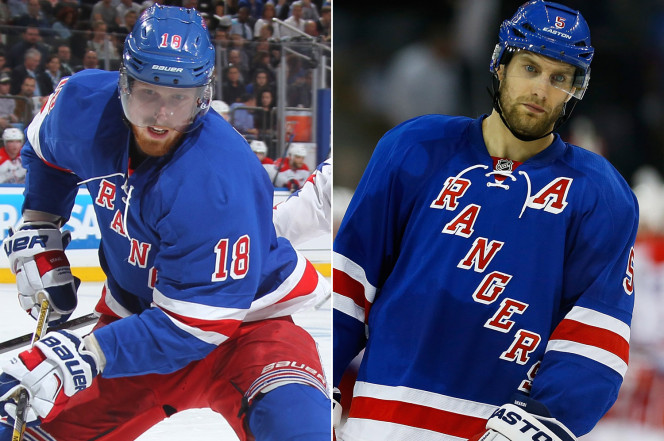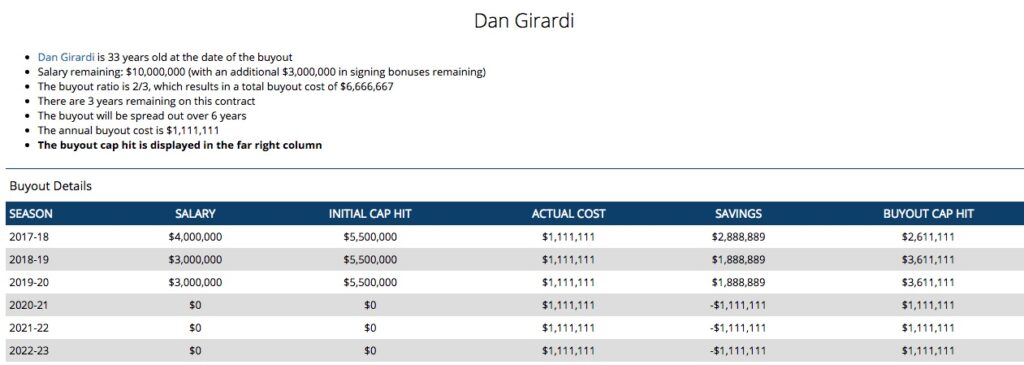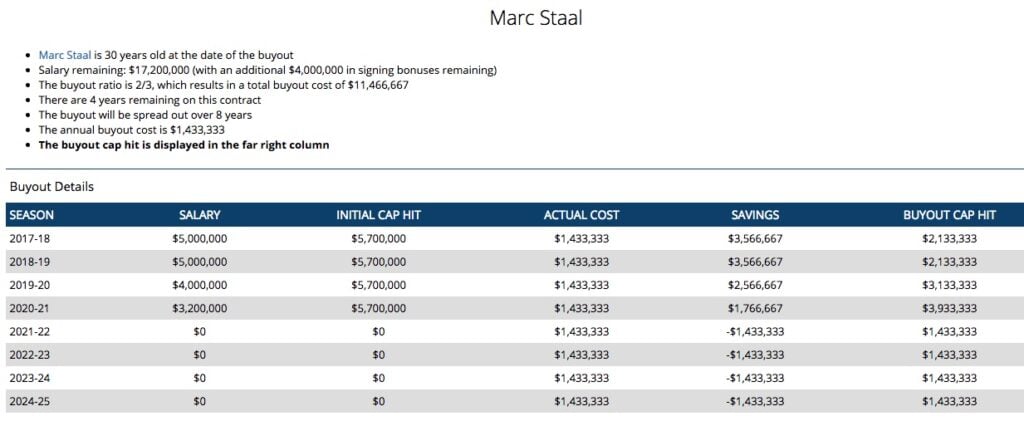One of the major topics this year is the futures of Marc Staal and Dan Girardi. It’s a necessary evil to discuss, as it’s become abundantly clear that neither can compete in the top-four, which is what they are paid to do. They both have flashes and both have good games here and there, but on the whole, neither are top-four anymore. It’s painful to say, as they have a whopping 21 years with the Rangers combined and have been the backbone of the Rangers’ resurgence to relevance since Lockout 2.0 (2005).
But here we are, discussing what the future holds for them. With a combined $11.2 million in cap space and three (Girardi) or four (Staal) years remaining, neither contract is desired across the league. The Wade Redden rule –and their no-move clauses– make it impossible to bury them in the minors. So the Rangers are left with two choices. The first is to buy them out. The second is to trade viable assets with their toxic contracts to rid themselves of the pair.
Let’s focus on the first option though. There is a lot of chatter that buying out their contracts results in the Rangers taking on more money. I’m not entirely sure where this talk comes from. Let’s be clear, buying out both contracts saves the Rangers money in the short term, when they need it the most.
Above is the cost of the Girardi buyout. On his current cap hit ($5.5 million), the Rangers would save $2.9 million this coming season and $1.9 million the next two seasons. Those savings are over the life of the remaining years on his deal, if not bought out. After that, it’s an additional $1.1 million for the following three seasons.
Above is Staal’s buyout. On his current cap hit ($5.7 million), the Rangers would save $3.6 million the next two seasons. That drops to $2.6 million in savings for 2019-2020 and down to $1.8 million in 2020-2021. Those four cap hits are savings based on the remaining years on his deal. After that, it’s $1.4 million for the next four seasons.
So let’s add these numbers together. If the Rangers don’t buyout either player, it’s $11.2 million in cap hits for players that simply can’t do it in their roles anymore. An argument can be made that having either of them playing significant minutes can severely hinder the Blueshirts’ ability to seriously compete for a Stanley Cup.
But by buying them out, the Rangers would have an additional $5.5 million in cap space to fill their roles. Let’s assume the Rangers are still going to have Ryan McDonagh, Brady Skjei, and Nick Holden (ugh) manning the blue line next year. Let’s also assume that the Rangers find a way to jettison Kevin Klein ($2.9 million). That gives the Rangers $8.4 million to re-sign Brendan Smith and find two additional defensemen.
Now here’s the kicker. The Rangers are expecting one of Neal Pionk, Alexei Bereglazov, or Ryan Graves to make the team out of camp. By all accounts, Bereglazov and Pionk are close or at NHL ready. Graves also had an impressive year. All three will be on ELCs will be at most $925,000 (Pionk, Bereglazov). Graves is at $657,000.
Even if Brendan Smith gets $4.5 million, the Rangers still make out in the end because they will have at least one more ELC (Skjei is still on his) on the blue line. No matter which way you cut it, the Ranges save huge over the next few seasons. Let’s also remember that Rick Nash’s $7.8 million cap hit comes off the books after next season. So for the 2018-2019 season, the Rangers are still in a good spot.
Now the concern is naturally going to be the additional years of dead cap space. The savings on Staal’s buyout actually negates the cost of Girardi’s first dead cap space year. So for all intents and purposes, the Rangers will have two years of $2.5 million in buyout cap hits and one year of $1.4 million. That will start in 2021-2022.
But you know who’s off the books by then? Henrik Lundqvist and his $8.5 million cap hit.
So while I certainly appreciate the cost ramifications of buying out both Girardi and Staal, don’t fall into the trap of thinking that both buyouts cost the Rangers more money. It’s a bad narrative that has unfortunately crept into the mainstream. The Rangers save big time money when they need it the most (NOW!), and their dead cap space years are offset by Lundqvist’s expiring deal.
Long story short, the Rangers need to make a change on the blue line and in the locker room. It begins with buying out their two worst defensemen, who also happen to be their alternate captains. This isn’t to say they are bad alternate captains, far from it. It’s to say that sometimes buying out bad players shows that the front office means business, and is in it to win it. It’s just business at this point, and it’s good business.
Share:
More About:Players



